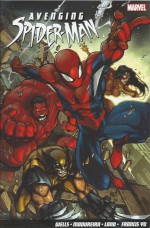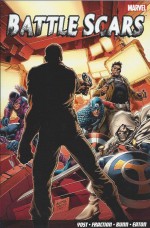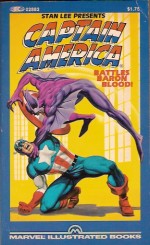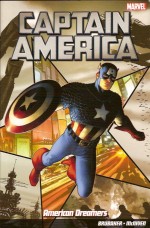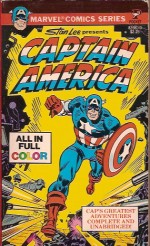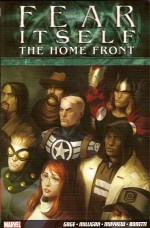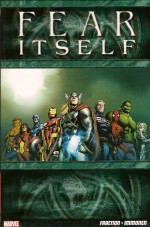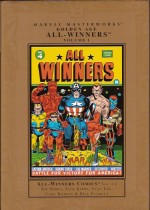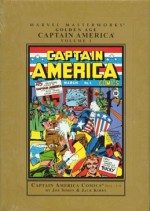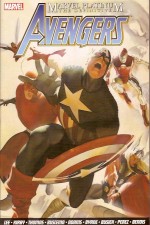
By Stan Lee, Jack Kirby, Roy Thomas, John Buscema, Neal Adams, John Byrne, Kurt Busiek, George Pérez, Brian Michael Bendis & various (Marvel/Panini UK)
ISBN: 978-1-84653-507-9
The Avengers have always proved that putting all one’s star eggs in one single basket pays off big-time: even when all Marvel’s all-stars such as Thor, Captain America and Iron Man were absent, it merely allowed the team’s lesser lights to shine more brightly.
Of course all the founding stars regularly featured due to the rotating, open-door policy which meant most issues included somebody’s fave-rave – and the boldly grand-scale impressive stories and artwork were no hindrance either.
As the new Avengers film screens across the world, Marvel has again released a bunch of tie-in books and trade paperback collections to maximise exposure and cater to those movie fans wanting to follow up the cinematic exposure with a comics experience.
Under the Marvel Platinum/Definitive Editions umbrella, this treasury of tales reprints some obvious landmarks from the pantheon’s serried history, specifically Avengers volume 1 #1, 4, 57, 93, Avengers West Coast #51-52, Avengers volume 3, #10-11, Avengers volume 1 #503, Avengers Finale and New Avengers #3 which, whilst not all absolutely “definitive†epics, certainly offer a sublime snapshot of just how very great the ever-shifting team of titans can be.
During the Marvel Renaissance of the early 1960’s Stan Lee and Jack Kirby aped the tactic which had worked so tellingly for DC Comics, but with mixed results. Julie Schwartz had incredible success with revised and modernised versions of the company’s Golden Age greats, so it seemed natural to try and revive the characters that had dominated Timely/Atlas in those halcyon days. The JLA inspired Fantastic Four featured a new Human Torch and before long Sub-Mariner was back too…
As the costumed hero revival brought continuing success, the next stage was obvious and is covered here at then end of the volume by historian Mike Conroy’s informative essay ‘The True Origin of the Avengers’…
The concept of combining individual stars into a group had already made the Justice League of America a commercial winner and inspired the moribund Atlas outfit of Stan Lee, Jack Kirby and Steve Ditko to invent many “super-characters†after the Fantastic Four. Nearly 18 months later the fledgling House of Ideas had a viable stable of leading men (but only sidekick women) so Lee & Kirby assembled a handful of them and moulded them into a force for justice and even higher sales…
After a period of meteoric expansion, in 1963 the burgeoning Marvel Universe was finally ready to emulate the successful DC concept that had truly kick-started the Silver Age of comics and this stunning historical retrospective begins as it should with two stories from the groundbreaking Lee/Kirby run which graced the first eight issues of the World’s Mightiest Heroes.
Seldom has it ever been done with such style and sheer exuberance. Cover-dated September, The Avengers #1 launched as part of an expansion package which also included Sgt Fury and his Howling Commandos and The X-Men…
‘The Coming of the Avengers’ is one of the cannier origin tales in comics. Instead of starting at a zero point and acting as if the reader knew nothing, Stan & Jack (plus inker Dick Ayers) assumed readers had at least a passing familiarity with their other efforts and wasted very little time or energy on introductions.
In Asgard Loki, god of evil, was imprisoned on a dank isle, hungry for vengeance on his half-brother Thor. Observing Earth he espied the monstrous, misunderstood Hulk and engineered a situation wherein the man-brute seemingly went berserk to trick the Thunder God into battling the monster. When the Hulk’s sidekick Rick Jones radioed the Fantastic Four for assistance, Loki diverted the transmission and smugly waited for the mayhem to manifest.
Unfortunately for him, Iron Man, Ant-Man and the Wasp also picked up the SOS….
As the heroes converged in the American Southwest to search for the Jade Giant they realized that something was oddly amiss…
This terse, epic, compelling and wide-ranging yarn (New York, New Mexico, Detroit and Asgard in 22 pages) is Lee & Kirby at their bombastic best and one of the greatest adventure stories of the Silver Age and is followed by the long-awaited return of the last of the “Big Threeâ€â€¦
Avengers #4 (March 1964) was a true landmark of the genre as Marvel’s greatest Golden Age sensation was revived. ‘Captain America Joins the Avengers!’ has everything that made the company’s early tales so fresh and vital. The majesty of a legendary warrior (that most of the readers had never heard of!) returned in our time of greatest need, stark tragedy in the loss of his boon companion Bucky, aliens, gangsters, Sub-Mariner and even wry social commentary. This story by Lee, Kirby & George Roussos just cannot be bettered.
In #57 (October 1968) Roy Thomas, John Buscema & George Klein produced a Golden Age revival of their own as ‘Behold… the Vision!’ introduced a terrifying android apparition designed by arch-foe Ultron to destroy the heroes. Sadly not appearing here is the conclusion wherein the eerie, amnesiac, artificial man with complete control of his mass and density discovered a fraction of his origins and joined the human heroes….
Avengers #89-97 comprised perhaps the most ambitious and certainly boldest saga in Marvel’s early history: an astounding epic of tremendous scope which dumped Earth into a cosmic war the likes of which comics fans had never before seen and creating the template for all multi-part crossovers and publishing events ever since.
The Kree-Skull War captivated a generation of comics readers and from that epic comes the extra-long ‘This Beachhead Earth’ (Avengers #93 November 1972, by Thomas, Neal Adams & Tom Palmer) as the Vision was almost destroyed by alien invaders and Ant-Man was forced to undertake ‘A Journey to the Center of the Android!’ to save the android’s unconventional life. Thereafter the Avengers became aware of not one but two alien presences on Earth: bellicose Kree and sneaky shape-shifting Skrulls, beginning a ‘War of the Weirds!’ on our fragile globe.
Acting too late, the assembled team were unable to prevent the Scarlet Witch, Quicksilver and Captain Marvel from being abducted by the Skrulls…
That cliff-hanging drama is followed by a revelatory two-part tale from Avengers West Coast #51-52 (November and December 1989) by John Byrne & Mike Machlan which opens with ‘I Sing of Arms and Heroes…’ wherein the Scarlet Witch hunted for her missing children only to discover some horrifying truths about them and her own powers. The tragedy was only resolved when demonic foe Master Pandemonium and supernal arch-tempter Mephisto deprived her of everything she had ever believed, wanted or loved in ‘Fragments of a Greater Darkness’…
Avengers volume 3, #10-11 (November and December 1998) by Kurt Busiek, George Pérez, Al Vey & Bob Wiacek) recaps the history and celebrates the team’s anniversary with a parade in ‘Pomp and Pageantry’ until the ghostly Grim Reaper hijacked the affair and attacked them through the medium of their own dead yet resurrected members Wonder Man, Mockingbird, Swordsman, Hellcat, Dr. Druid, Thunderstrike and Captain Marvel. At the same time the increasingly unstable Scarlet Witch learned the true nature of her reality-altering powers in the catastrophic concluding clash ‘…Always an Avenger!’
A few years later the “World’s Mightiest Heroes†were shut down and rebooted in a highly publicised event known as Avengers Disassembled. Of course it was only to replace them with both The New and The Young Avengers. Affiliated comic-books Thor, Iron Man, Captain America, Fantastic Four and Spectacular Spider-Man ran parallel but not necessarily interconnected story-arcs to accompany the Big Show.
Said Show consisted of the worst day in the team’s history as a trusted comrade betrayed the World’s Mightiest Superteam resulting in the destruction of everything they held dear and the death of several members, all of which originally appeared in issues #500-503 plus the one-shot Avengers Finale.
From that epic event comes the closing chapter ‘Chaos part four’ (#503, December 2004, by Brian Michael Bendis, David Finch, Olivier Coipel & Danny Miki) wherein the uncomprehending, surviving heroes discovered and reluctantly despatched the true author of all their woes and losses, after which the moody and elegiac Avengers Finale signalled the end of an era in a powerful tribute by a host of creators including Bendis and artists Finch, Miki, Frank D’Armata, Alex Maleev, Steve Epting, Lee Weeks, Brian Reber, Michael Gaydos, Eric Powell, Darick Robertson, Mike Mayhew, Andy Troy, David Mack, Gary Frank, Mike Avon Oeming, Pete Patanzis, Jim Cheung, Mark Morales, Justin Ponsor, Steve McNiven, George Pérez, Mike Perkins, Neal Adams & Laura Martin.
It is undeniably one of the best superhero “Last Battles†ever created, and loses little impact whether it was your five hundredth or first experience with these tragic heroes.
Shocking and beautiful, there was a genuine feeling of an “End of Days†to this epic Armageddon.
The final comics tale in this sturdy volume comes from New Avengers #3 (March 2005) as, in the aftermath of a massive breakout of super-villains, Captain America and Iron Man tried to put the band back together with a whole new generation including Luke Cage, Spider-Woman and the Amazing Spider-Man.
‘Breakout Part 3’ is just a fraction of a longer epic by Bendis, Finch, Allen Martinez, Miki & Victor Olazaba, but ends this action-adventure compendium on a solid note indicating that the best is still yet to come…
Also contained herein is an extensive prose feature covering the history of the team, the aforementioned ‘true origin’ piece and a raft of classic covers to tantalise and tempt…
This book is one of the very best of these perennial supplements to cinema spectacle, but more importantly it is a supremely well-tailored device to turn curious movie-goers into fans of the comic incarnation too. If there’s a movie sequel, I’m sure Marvel has plans for reprinting much of the masterful material necessarily omitted here, but at least until then we have a superb selection to entice newcomers and charm the veteran American Dreamers.
™ and © 1963, 1964, 1968, 1972, 1989, 1998, 2004, 2005, 2012 Marvel & subs. Licensed by Marvel Characters B.V. through Panini S.p.A, Italy. All Rights Reserved. A British edition published by Panini UK, Ltd.
